A Most Merry and Illustrated History of
The Life and Times of
Thomas Paine
America's (or rather Britain's - or is it France's?)
Irascible Revolutionary
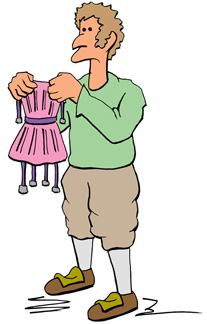
Tom Paine: Before the Revolution
Revolutionary Staymaker
Tom Paine is without doubt the most famous underwear maker in history. Or to use the term from his own time, he was a staymaker. That is, he made ladies corsets.
As did most craftsmen of the times, Tom learned his trade serving as an apprentice to a master. In Tom's case, the master was his dad, John Pain (as the last name was first spelled). John was a Quaker but had married an Anglican lady named Frances Cocke in Thetford. Thetford was (and is) a prosperous town in the county of Norfolk which is about 80 miles northeast of London. It was there that Tom was born on January 29, 1737. Of course that was using the old Julian Calendar and nowadays Tom was born on February 9.
In those days, mixed marriages like those of John and Frances were generally frowned on. Some biographers even say that Jon got even kicked out of the Society of Friends because of it. But this doesn't really appear to be the case. When John died he was still listed as a Quaker.
Not that families like Tom's may not have felt community disapproval, and Tom's time at Thetford has been cited as shaping Tom's later revolutionary character. Well, maybe, but as far as we can tell, Tom grew up to pretty much with the views and aspirations of a typical Englishman. But this was the time that people began to break free of the traditional class hierarchy and aspire for better things. Of course, it didn't take much to get Tom to want better things. As a journeyman corset maker, he would have made maybe £25 per year. He was also forced by law to work from 6 a. m. to 8 p. m. A request by the corset makers to reduce the hours to 6 a. m. to 7 p. m. was denied.
So maybe it's not such a surprise that in 1756, when Tom was nearly 19, he ran away to sea. It had been only two years that the Seven Years War - the French and Indian Wars in America - kicked off when a young Virginia militiaman named George Washington ordered his soldiers to fire on a French diplomatic mission. So you could sign up to fight for George III, just as your grandfather could have fought for George I, your dad for George II, and your sons for George IV. Naming of kings showed remarkably little imagination in those days.
But serving the Navy had its drawbacks. Although the picture of the "brutal service" of the Navy has been exaggerated in fiction, you could still land a dozen lashes with the cat-o-nine tails for things like showing "disrespect" to an officer. To avoid the more strict discipline of the military, you could get a job as a navy contract worker - or as they called them then, "privateers".
The term "privateer" could refer either to the individual or the ship itself. The privateer's job was not to fight French warships, but to capture enemy merchant vessels. You seized the ship and sent the ship in to what was called the Admiralty Court. If the court determined the ship was a legitimate prize, the ship and cargo were auctioned off. The government got its percentage, and the remaining parts of the pie were divided among the privateers (civilian crews on the captured ships were usually released after the proceedings). Of course the ships owners and officers got the largest percentage, but even a beginner privateer like Tom could make a decent amount for a few months work. Unfortunately, being a privateer also entailed some risks. Casualties were as high as 50 %, and worse, captured privateers were sometimes tried as pirates and hanged.
But as they say, ready cash strengthens the faint of heart, and Tom signed up on a ship (so he said) named the Terrible which was commanded by a man named - get this - Captain Death, though we suspect this name may be a pseudonym. The ship set sail in November 1756 and was almost immediately lost during a fight with a French ship Vengeance. Only 17 men of the original 167 men escaped. Tom was not on the list of survivors.

Tom signed up with Captain Death.
Of course, that's because Tom wasn't even on board. Just before the Terrible was to sail, his dad had shown up at the London docks and begged Tom not to go to sea. Tom said OK and got a job in London as - yes, a corset maker.
We shouldn't forget that Tom was still a teenager, so it's no surprise after his dad returned to Thetford Tom signed on to another privateer. The ship was the King of Prussia, and this voyage was a success. Within six months the King of Prussia, sometimes alone and sometimes acting with other ships, captured six French merchantmen. Tom, as the lowest ranked member on the crew, got perhaps one half of one percent of the prize money. Still when the trip ended Tom was paid something like 30 pounds - more than a corset maker could make in a whole year.
It was now the winter of 1758, and with good money in his pocket, Tom decided to spend his time improving his mind. He stayed in London, attended science lectures, and met some of the famous thinkers of the time. This was a time when science, philosophy, religion, and art all got along pretty well. One of the lecturers Tom met, James Ferguson, was not only an astronomer of note, but also a portrait painter and a friend of Benjamin Franklin.
In 1758 the Enlightenment was in full swing. Questioning tradition was not only OK, but cool and fashionable. In Europe the politicians had been pushing the old absolutist governments toward constitutional monarchies, and there were some people - called Republicans - who believed there should be no kings at all. But despite the reasonable amount of free speech that existed in eighteenth century England, if you really began to speak about overthrowing kings, you might find yourself, as they say in Boone County, Kentucky, in a heap of trouble, boy. A little spirited debate in the taverns was fine, but you had to be careful.
Tom enjoyed himself in London but soon found £30 would only go so far. So as the winter turned to spring, he set himself up once again as a corset maker. His new business was in Sandwich, about forty miles southeast of London. He got along OK and made friends with the locals, attended church (and some say even preached sermons), and met a young lady named Mary Lambert.
Some biographies mention Tom had one wife whom he later left. But he actually was married twice. Mary was his first, and they married in 1759. However, corset business had undergone a slump, and the newlyweds moved to Margate about 10 miles north of Sandwich. But Mary died in less than a year.
Making ladies' corsets had less and less appeal. Surely there were better jobs around. So he wrote his dad, asking if the now successful Mr. Pain Senior could use his influence in getting his son a better job. Tom wanted to be an exciseman.
An exciseman was a government employee. They were responsible for appraising inventories of merchants for taxation, especially those involving import and export. It was not an easy job to get. In fact you even had to apply to be instructed for the job. If that request was approved, you were then taught the business. Once you were evaluated to have the necessary skills (which included being able to gauge the quantities of casks of various sizes, do the needed arithmetic, and have good handwriting), you then applied for the actual job. Of course, politics played a big part in who was hired, but Tom finally received the appointment in 1762.
Tom was appointed as the excise officer in Grantham, later to be the home of an Oxford chemist named Margaret Hilda Roberts who, like Tom, liked to change jobs. Although we can debate endlessly whether Hilda was popular in her new profession, we know that excisemen were not. They were, after all, tax assessors, and sometimes they had to collect the money themselves. They would also ride around the countryside looking for smugglers which had its own hazards. But the pay was better than corset making, about 50 pounds a year.
On the other hand, being an exciseman was not a 9 to 5 desk job. It involved a lot of travel in a day where travel was even more of a pain than it is today. You also had to deal with irritated townspeople who in general didn't like government officials butting their noses into local businesses.
So to relieve this double burden, excisemen sometimes would access the goods without actually paying anyone a visit. Called "stamping", the practice was sometimes done with the cooperation of the merchants themselves. You sat in your office and just entered an assessment for a particular business whose owner let you know how much he would be willing to pay. He might even give you a little extra for your efforts. So stamping had the advantage that you didn't have to travel to assess the goods, and the merchants didn't have to worry about visits from the excisemen. Alas, stamping was, of course, illegal.
One story is that irregularities were found in Tom's notebooks, there was an investigation, and he confessed to stamping. However, there are no actual documents on record about Tom's peccadilloes nor of any confession. Instead, there had been a report that Tom's boss, William Swallow, was deliberately miscopying Tom's notebooks. But William blamed Tom for shoddy bookkeeping. As everyone knows, when the boss is in trouble, the first thing he does is to blame someone further down the line. And we know who wins in such circumstances. Tom was dismissed from the service.
There wasn't much to do but go back home to Thetford. With his dad's help, he got a job at Diss, a small town about 15 miles away, again as a corset maker. But once more making ladies' undergarments soon paled, and after a suitable interval, Tom requested his old excise job back. Perhaps the excise board suspected it wasn't Tom who caused the problems, and they granted Tom's request. In July 4, 1766 - exactly one decade before another important date - he was reinstated. He had to wait for an opening, though, and he also wanted to make sure he didn't go to some backwater one-ox village. So it wasn't until 1768, that he accepted a post in the town of Lewes which is close to the resort town of Brighton.
Tom moved in with the family of Samuel Ollive (Ollive is the name, not a misprint). Samuel and his family ran a tobacco and snuff shop and since at that time the T & S business was not doing that great, they were glad to take in the young boarder. Tom was also happy to be there and soon was giving the big eyes to Elizabeth, one of Samuel's daughters.
Of course, even busy excisemen could take some time off, and with no television or Internet, a young man with wide interests could join various clubs. A particularly popular club was called the Headstrong Club (whose real name may have been the White Hart Evening Club). They met once a week to have dinner, drinks, and to debate the topics of the day. Tom was soon considered to be the best debater by far, and it's a good bet that one of the topics they hashed out was the ongoing problems England was having with the colonies in America.
Tom also began to write. Much of what he wrote remained unpublished, but there were some newspaper articles and letters that have been traditionally credited to him (most articles and letters of the time were unsigned). Before long Tom had acquired the skills that would later serve him well. Still, he was not much different from any other of the townspeople, and people remembered him mostly as an affable young man with a good political knowledge.
Then in 1769, Samuel Ollive, Tom's landlord, died, and Tom may have briefly returned home to Thetford. But in any case, in 1771, he was back in Lewes and was helping the Ollive family run their business. It was also this year that he finally married Elizabeth.
Throughout this time Tom continued to serve as an exciseman, and he had come to the conclusion that they were underpaid. So he went around collecting petitions from his colleagues, and leaving Elizabeth to run the tobacco business, he headed north to London. He then went around to various officials and MP's arguing for increased salaries for excisemen. After several months he had accomplished absolutely nothing except irritating a lot of people. In fact, he was really pushing the limits, and in some European countries, he would probably had been arrested for petitioning against the government.
Well, you can guess what happened. He got back home, and he was booted from his job again. The official reason was being absent from his post, but it was really because he had become a pain in the derrière, something he would soon excel at. But things got worse.
There had been rumors that Tom and Elizabeth weren't getting along, and his long absence in London fueled the gossip. The tobacco and snuff business still wasn't doing very well, and the debts began to accumulate. There were clearly personal problems and supposedly a local physician visited Tom - who was twice Elizabeth's age - to investigate Tom's lack of fulfillment of his husbandly duties.
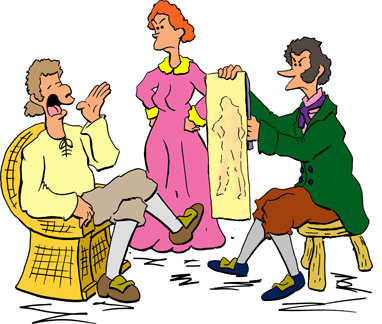
The Investigation.
But money was the most immediate concern, and in the first part of 1774, Tom and Elizabeth had to declare bankruptcy. To settle the debts they had a public auction of their goods, and Tom and Elizabeth decided to separate. They drew up a formal agreement where Elizabeth gave Tom some dough, and he went back to London.
Tom always remained tight lipped about the exact cause of the split. When asked about Elizabeth, he would say it was his own personal business and didn't bother with impertinent questions. But in any case, with Elizabeth's settlement, Tom had enough money to last for a while.
The question was what was he going to do? One thing he was certain of. No more corset making or tax collecting. He needed a clean break and a new direction.
When Tom began studying science it would have been impossible for him to ignore the writings of Benjamin Franklin. From the mid-1700's Ben had become the epitome of the self made man of the Enlightenment. He started out as a printer who ran away from an apprenticeship, became an author of popular essays (even today "A Letter To A Royal Academy", later renamed "Fart Proudly", remains a classic), and a writer of maxims and aphorism such as the immortal "The greatest monarch on the proudest throne is obliged to sit upon his own arse" and "Force shits upon reason's back".
But it was Ben's fame as a scientist that propelled him to the world stage. When Tom left Lewes, Benjamin Franklin was literally the most famous man in the world. He was man who tamed lightening and developed the first more or less correct theory of electricity (although he guessed wrong about which was positive and which was negative). But in 1774, Benjamin had been living in London for nearly 18 years, serving as agent to Parliament for the American colonies.
Tom, the unknown ex-excise man, former corset maker, and past snuff and tobacco dealer, asked for an appointment to meet the great man. Possibly, their mutual acquaintance with James Ferguson helped pave the way. In any case, Ben, always affable and generous, welcomed the younger man warmly. We don't know exactly what they said, but Ben must have been impressed and gave Tom a letter of introduction to his son-in-law, Richard Bache. Tom, Ben wrote, is an able and intelligent young man of good character. Perhaps his son-in-law would make him welcome in Philadelphia and even put him into touch with some people who might give him a job like a clerk or assistant tutor or surveyor. So Tom headed off to America.

Ben must have been impressed.
Tom The 'Merkin
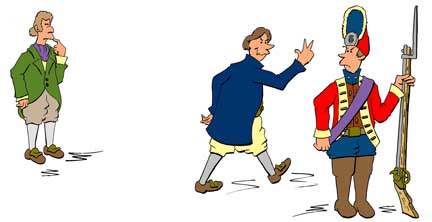
Tensions had been growing.
Tom arrived in America at a very touchy time. Tensions between the colonies and England had been growing for more than a decade. The problems were both general and specific. Generally, the colonists were simply looked down on as (ptui) "provincials" and not given equal opportunity in the British Empire. If an able young man from America wanted to rise in the Empire, he was pretty much jack out of luck. The few exceptions (such as William Franklin, Ben's son, who later rose to become the Royal Governor of New Jersey) did nothing except let the English deny there was such a problem. In fact, the young George Washington had become so frustrated with trying to get a commission in the British Army that he finally gave up and retired to his farm inherited from his older brother and funded largely by his wife's wealth.
But specific problems between England and the colonies, like so many problems today, had to do with money. Beginning in the mid-1760's, the English Parliament passed a number acts that irked the colonists by asking to help pay for the cost of creating an empire on which the sun was soon not to set. In 1764, you had the Sugar Act, which increased duties on sugar and related imports, and then to help streamline the transfer of the new taxes to England, Parliament also passed the Currency Act which forbade the colonies from issuing their own coins. Then the next year you had the Stamp Act which required payment for placing a stamp on most printed goods, and finally came the Quartering Act which required the colonists to provide British soldiers with food and lodging in private homes. Although all these acts were resented, it was really the Stamp Act that the Americans didn't like
Today people may wonder - as did the Englishmen of the time - what was the big deal. People had been paying taxes for thousands of years. And the Stamp Act had been passed routinely and with almost no discussion to help pay for the French and Indian Wars that had been for the colonists protection. Even today you'll get revisionists about what a bunch of greedy self-centered jerks the American colonists were for not wanting to pay their fair share to run the government.
But the tax really was a burden. Almost everything colonists used on a daily basis was now taxed. Marriage licenses, contracts, deeds, wills, birth certificates (including baptismal records), almanacs, pamphlets, diplomas, shipping forms, posted advertisements, newspapers, and even dice and playing cards were subject to the tax. The costs, of course, added to the usual prices for all these items. So although for any individual item the amount might seem small, the cumulative affect was stretching the finances of even the prosperous middle class. Also Parliament did not seem to think things through and required the tax to be paid in English sterling - ergo, English silver coins - specie most colonists had never even seen, much less had in hand.
There was a huge outcry from the colonists, followed by a boycott of British goods. Soon groups of colonists began using intimidation tactics which today we would label as terroristic. Armed mobs broke into the homes and offices of the stamp officials, and the men were physically attacked. Although there are no records of any officers being killed, some were coated with hot tar and feathers, and the stamps were destroyed. Even homes of some of the colonial governors were invaded and torn apart. Most of the stamp officials became so terrified that virtually all resigned in short order. Some didn't hold their offices for even a day.
Back in England, the get-tough-on-crime MP's went into spittle flinging diatribes and said that the colonists had to obey the laws. But the colonists said that the laws themselves were illegal, and Parliament had to obey England's own constitution, even though there really wasn't one. But this wasn't just an England vs. the Colonies fight. There were also a number of pro-American MP's such as William Pitt and Edmund Burke who defended the colonists' right to resist.
The boycott was hurting British businesses, and soon Parliament voted to repeal the Stamp Act. But to show England was still in charge, in 1767 Parliament passed a series of laws known as the Townsend Acts. The MP's thought that these acts - which taxed a number of items that were not manufactured in the colonies - would be OK. However, the items taxed were still used on a daily basis, and were levied on glass, paint pigments, paper, and tea.
The MP's just didn't seem to get it. OK, we'll repeal the Stamp Act. But we'll enact the Townsend Acts that still imposed taxes. To enforce these laws we'll send even more the troops to strut around, and ticking everyone off even more.
We need to also mention that part of the problem here was that this was the time of the Great King / Parliament Experiment. The king, George III, had begun taking more active role in not just reigning, but ruling the country. George, although by no means a bad ruler, was not (as he himself recognized) a man of great depth of learning. He was also rather stubborn, inflexible, and obstinate, and compromise was not something he liked to do.
Tensions continued to rise, and by 1770, colonists were actively taunting the soldiers whom they saw on the streets. On March 2, a colonist asked a soldier if he was looking for work (a lot of soldiers moonlighted). The soldier said, yes, and the colonist invited the soldier to "clean my shitehouse". The soldier returned with a group of his buddies and a fight broke out, but eventually the mêlée subsided.
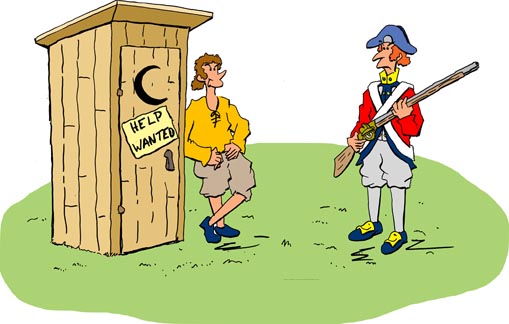
The soldiers looked for extra work.
Then three days later, March 5, a British officer, Captain John Goldfinch, was walking past a barber and wigmaker's shop. An apprentice, a young man named Edward Garrick, came out the door and proclaimed that Captain Goldfinch hadn't paid his bill, even though the Captain claimed he actually had the receipt in his pocket. A soldier from the Customs House, Private Hugh White, was standing nearby and said that the officer was a gentleman and would pay his what he owed. The apprentice snorted there were no gentlemen in his regiment.
During the Georgian era, the word "gentleman" was more exclusive than it is today. Today anyone can be a "gentleman" if they try, but in the eighteenth century, the word particularly referred to a man of means who did not work at a trade. It also implied that you behaved in a dignified and courteous manner as befitted one of education. Because many officers of the military were from well-to-do families and had actually paid - yes, paid - for their commissions, it was a given that an officer was a gentleman. For instance, Fletcher Christian - who in about fifteen years would lead the famous mutiny on Her Majesty's Armed Vessel, the Bounty, was officially a gentleman.
So in polite English society, one of the worst things you say to an army officer was that he was not a gentleman, and common soldiers, then as now, would consider an insult to a respected officer as an insult to the service and themselves. Although Captain Goldfinch simply ignored the gibe, Private White went up to Edward and the men exchanged hard words. The story is that Private White then struck Edward with his musket and knocked him down. Soon a group of a dozen hostile colonists had gathered around.
Almost simultaneously two other crowds that night had accosted groups of soldiers. Those crowds decided to go after the main guard at the Custom House just as the angry men gathered around Private White. Soon the now unified mob was far too large for the soldiers to handle.
Private White was being directly threatened. Words flew out like "lobsters", "bloody backs", "rascals", and other phrases not found on a family website. Private White began to get pelted with snowballs, and he retreated back to the Customs House.
Normally the guns of the soldiers were not loaded. But Private White now armed his weapon and called for back up. There were only eight soldiers including their captain, Thomas Preston.
Captain Preston was in a quandary. Although his men were armed, the crowd was too large for the soldiers to disperse. In fact - something not well known today - it was actually forbidden for soldiers to fire on colonists without a judge's approval. And you think law officers are burdened by red tape now.
Well, we know what happened. After another soldier, Private Hugh Montgomery, had been struck with a club, he called out an order for the men to fire. Five colonists were killed (including a black sailor, Crispus Attucks). News of the "bloody massacre" spread though the city and then through the colonies.
All eight soldiers were arrested for murder. They were at a loss for a defense attorney until John Adams - later one of the strongest advocate of independence, but who felt everyone should have a fair trial - took the case. All but two of the soldiers were acquitted outright. Those two were convicted of manslaughter and received what was then a quite lenient sentence of branding on the thumb.
The Boston Massacre (as we call it today) convinced Parliament that they had to back down, and by 1773, most of the Townsend Acts had been repealed. But again to show England was in charge, Parliament kept the tax on tea. But to sweeten the deal (no bad joke intended), Parliament said, look, we'll make it so the price of tea actually drops. Then we'll just tack on a small tax and so you'll actually come out ahead.
But by this time the colonists were themselves fed up with a Parliament determined to tax something. So on December 16, a group of colonists dressed up as Native Americans. Then they went to the harbor, and seized the tea on board three ships and dumped it all overboard. So there.
Well that did it. If colonists were fed up with a Parliament intended to tax, Parliament had had enough of the Americans whom Dr. Samuel Johnson said were a "a race of convicts, and ought to be thankful for anything we allow them short of hanging." The "Intolerable Acts" were passed in short order. Among other things Parliament closed Boston port until the tea was paid for, disbanded the Massachusetts legislature, and instituted direct rule from England under a military governor, Sir Thomas Gage.
This was the situation when Tom disembarked. Actually, he was carried down the gangplank as he had been struck with typhus while on the trip over. The ship, the London Packet had left England at the end of September, and the voyage took two months. Today this rate of travel seems excruciatingly slow, but it was really about 50 miles a day and not a bad clip back then. The ship landed in Philadelphia on November 30, 1774.
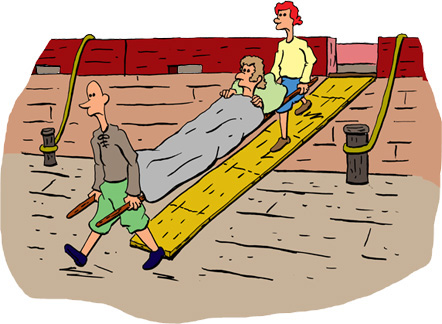
Tom arrives in Philly.
Tom was too sick to do anything for a month. Fortunately, the captain of the ship, John Cooke, had known Tom when he lived in Lewes and had a brother and sister-in-law who lived in Philadelphia. They let Tom recuperate at their home. By January, 1775, Tom felt well enough to go have a look at Philadelphia.
It's hard to believe now, but the Town That Would Eventually Snowball Santa Claus was the center of art, science, and culture in the New World. Not only was it the home of Benjamin Franklin, but it housed many other luminaries of the day like David Rittenhouse (optician and astronomer), Benjamin Rush (physician), and the famous Peale family of artists. Among Philly's many attractions was the excellent local beer which John Adams, who was in town, found a most refreshing drink to start the day.
Once he got up and was moving about, Tom took his letter of introduction from Franklin and paid a call on Ben's son-in-law, Richard Bache. Richard in turn introduced Tom to some of Philadelphia's leading citizens. Tom had enough money to tide him over for a while, and he began to frequent the local coffee shops where the intellegensia liked to meet and discuss the issues of the day.
Tom also liked to browse bookstores. Bookstores, for those who are too young to remember them, were retail outlets that sold non-electronic devices with white flappy things in the middle. They also carried a selection of magazines, newspapers, and the particularly popular pamphlets about whatever topics were of current interest. Browsing through bookshops was considered a pleasant way to pass an hour, and if you were a regular customer you would inevitably meet the owner.
Sure enough in one of the local bookstores on Front Street, Tom met the proprietor, Robert Aitken. Robert was impressed with Tom's knowledge, and Tom showed him some articles he had written but had not published. Coincidentally, Robert had been planning to start his own newspaper and was looking for an editor, and he offered Tom the job. So in little more than a month of his arrival, Tom became the editor of the Pennsylvania Magazine at £50 a year which was the same pay Tom had received as an exciseman but now it was for a much more satisfying job.
Tom the Journalist

Tom got the job.
Tom jumped into being an editor with great élan. It took a lot of work but the first issue came out on January 25, 1775. There was really no single topic. There were articles about local prices, the weather, and new books. Tom and Robert also decided to accept articles on politics and religion but would not advocate one side or the other.
The magazine did print the petition that had been sent to King George by the first Continental Congress saying that the Americans wanted to stay loyal to England and the crown, but it was getting tough. Even after the Boston Massacre and the Intolerable Acts, virtually all Americans still claimed fealty to the king and were opposed to independence. After all, championing independence was nothing less than treason. But the colonists decided they needed to take some kind of collective but legal action, and and so they formed the First Continental Congress which met in Philadelphia from September 1774 to May 1775. Finally, they decided to write up the petition and send it to King George.
Despite the Philadelphia Magazine's policy of avoiding controversy, Tom began to accept, commission, and even write articles that took the side of the colonists. Tom agreed that the English (unwritten) constitution mandated no one could be taxed without Parliamentary representation and without the requisite representation there should be no taxation.
It was at this time that Tom also began to express abolitionists sentiments. For five thousand years, civilizations had slaves, and no one - that's no one had ever suggested that slavery as an institution was wrong. But during the Enlightenment, some people, like Jean Jacques Rousseau, wrote all master/slave societies were wrong. But although slavery had been abolished in England by judicial ruling in 1772, it was still permitted in the colonies, and Dr. Rush had called for total abolition everywhere.
Tom agreed with Dr. Rush. Tom wrote that all slaves should be freed, those who were old should be cared for, and the younger ones taught trades so they could support themselves. But he also went so far to question how could anyone who professed Christianity accept slavery. He was particularly harsh on Christians who justified slavery based on interpretations of the Bible.
The situation between the colonies and England was not improving. In April, 1775, General Gage, still the military governor up in Boston, had heard that the colonists - even now the term "rebels" was being used - had been stockpiling arms about ten miles west of Boston in the villages of Lexington and Concord. It was those rabble rousers again, the tubby slovenly Samuel Adams and the wealthy sawed-off shrimp John Hancock, who were behind it. So on April 6, 1775 General Gage sent a column of soldiers to seize the arms and arrest Sam and John.
The colonists now had a network of informers, and there wasn't much the British could do that could be kept secret. As the British began to march west, three Bostonians, Paul Revere, William Dawes, and Samuel Prescott, got on their horses and began to spread the alarm that the British were coming. Paul was captured and briefly detained, but Sam and John managed to get away.
The British were led by Lieutenant Colonel Francis Smith and under him were soldiers commanded by Major John Pitcairn. Major Pitcairn had headed toward Lexington about 10 miles west of Boston. But as Colonel Francis later wrote, alarums were now being sounded throughout the countryside, and when the Redcoats (a more polite term than "lobsters" or "bloody backs") got to the town green, they found a group of militiamen - that is private individuals who banded together in times of public danger - standing there with muskets in hand. Major Pitcairn told the "damn'd rebels" to lay down their arms. Then someone fired a shot. If not heard round the world, it was certainly heard by the soldiers and local people. More shots were fired and eight of the colonists were killed.
Colonel Smith had continued to a bridge over the Concord River where they met more militiamen. Again fighting broke out and after regrouping with Major Pitcairn, Colonel Smith decided the best thing to do was return to Boston. On the way back the soldiers were subjected to musket fire from all sides.
The number of casualties depends on your source. Some say over 200 British were killed; others say it was bit more than a hundred. Or maybe it was about 70. Ignoring the fact that the historical record isn't clear (Colonel Smith's report gave no figures), sometimes people tend to mistake the word "casualties" for the number actually killed. Anyone killed, wounded, or missing in action is a casualty (strictly speaking, a casualty is anyone who does not report for duty after a battle). Whatever the number, it was enough for the British to realize they had lost this "battle", and the damn'd rebels had won.
Even after the Battle of Lexington and Concord, many Americans still did not favor independence - or at least few would admit it. Right after the battle, in May 1775, the Second Continental Congress convened. It began its business by sending another petition to the king. Despite the fact that American colonists were now shooting at British soldiers (and vice versa), Congress affirmed their loyalty to the king and their desire to remain as subject of the British Empire. They blamed the "irksome" ministers of the government as the cause of the problems and hoped that the king could fix things.
Fat chance. As that petition was sent off, crossing the Atlantic was a proclamation by the King that the colonies were in a state of intentional and active rebellion, a state of affairs that was in accord with developing events. In June the colonists and British again clashed at the misnamed Battle of Bunker Hill. Although the British officially won, their casualties were high. The 3000 man force suffered over 30 % casualties of which about 20 % were killed.
Crossing with King George's proclamation were more English troops under two military brothers, Admiral Sir Richard and General Sir William Howe. William, who was a friend of Benjamin Franklin, had full powers of negotiation. He even managed to meet with Ben and John Adams to discuss a peaceful settlement. The meeting was cordial (even though the night before Benjamin and John had to share a bed), the negotiations came to naught. Unbeknownst to Ben or John, Sir William also had a list of the "rebels" who were to be pardoned. Ben was on the list; Johnny was not.
Regardless of what the average American thought, as 1775 came to a close, Tom believed that things had reached the point where reconciliation was no longer possible. The fact that England was sending hired Hessian soldiers (i. e., Germans) did not help cement relations. Tom decided to write a short pamphlet that would explain the advantages of independence. He wanted to call it Plain Truth, but Benjamin Rush suggested a less religious sounding title. So they agreed on Common Sense.
Common Sense
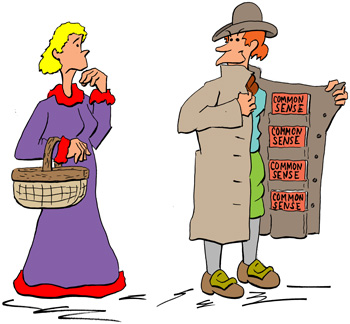
Common Sense: Copies abounded.
Common Sense hit the newsstands on January 10, 1776 and was an immediate success. The actual number of copies isn't known but nigh on 200,000 may have been sold in the first six months. But due to the vagaries of the deal with the printer and publisher (usually printers were the publishers), lack of copyright laws, and donating part of the profits to the Continental Army, Tom claimed didn't make a dime. Soon pirated copies abounded.
In the pamphlet, Tom began by discussing the tyranny imposed by England on the colonies. It didn't matter, he said, if the tyranny was from a king or from a Parliament. Both governments were forced on the colonists, and both were tyranny. The American colonies needed to be independent.
Next Tom goes after the king - or rather the monarchy. Having a monarchy just made no sense and Americans should not continue with even a constitutional monarchy. Ruling by heredity was crazy. That was nuts and would keep people with the true talent from running the country. Tom sometimes let his sardonic humor creep though, like when he wrote "One of the strongest natural proofs of the folly of hereditary right in kings, is, that nature disapproves it, otherwise she would not so frequently turn it into ridicule by giving mankind an ass for a lion."
Tom also discussed why continued union with England was not tenable. The sheer distance made communication of grievances too slow for meaningful resolution. There was also no better time than the present to split the colonies as an independent country from the mother country.
Finally Tom advised what the colonists should do. They should set up their own Congress with elected representatives and a president. The former would pass laws and the latter would approve them.
As popular as the pamphlet was, not everyone agreed with Tom. Even those who approved of the overall sentiments - separation from England; no monarchy - didn't always like the details of Tom's proposed government. John Adams wrote that Common Sense advocated a government with no checks and balances, and one that could become a tyranny of the majority. What he found particularly of concern was the call for a unicameral congress. John said you needed two legislative bodies, one with direct elections but another with more independence.
Although Common Sense was issued anonymously, the authorship was not kept secret for long. You might think Tom had to keep his name off the pamphlet because he voiced treasonous sentiments, this wasn't necessarily so. As we said, writing in those days was often anonymous, and certainly the printers were never arrested even though they were equally - quote - "guilty" - unquote - of spreading treasonous sentiments. There was even an English edition, also published in 1776.
Suddenly it became, not only acceptable, but rather chic to advocate independency (as independence was called at the time). By the time Richard Henry Lee got instructions to propose that "these United Colonies are, and of right ought to be, free and independent states, that they are absolved from all allegiance to the British Crown, and that all political connection between them and the State of Great Britain is, and ought to be, totally dissolved", most everybody was on board.
The resolution was approved with "no dissenting votes" [New York abstained] in early July, and John Adams proclaimed (or rather wrote to Abigail),"The second day of July, 1776, will be the most memorable epoch in the history of America. I am apt to believe that it will be celebrated by succeeding generations as the great anniversary festival. It ought to be commemorated as the day of deliverance, by solemn acts of devotion to God Almighty. It ought to be solemnized with pomp and parade, with shows, games, sports, guns, bells, bonfires, and illuminations, from one end of this continent to the other, from this time forward forever more." Maybe it was just to irritate John but the actual adoption of the declaration penned by Thomas Jefferson was delayed two days.
Tom had found his métier. However, you can only write so many blockbuster political pamphlets and in the meantime Tom decided to enlist in the Continental Army. On July 5, 1776, Tom joined a brigade which marched to Perth Amboy and spent the next three months watching the British ships sail in and out past Staten Island. At that time three months was the standard term of service and afterwards Tom went up the Hudson where General Nathaniel Greene was stationed with his men at the north end of Manhattan. Officially Tom was an aide to Nathaniel but spent much of his time writing articles for the newspapers. He was, his comrades in arms remembered, a better philosopher than a soldier. This rather idyllic life ended when Lord Charles Cornwallis attacked Greene's soldiers who - and we have to be honest here - ran like scared rabbits and headed south through New Jersey. Tom remained with the Army and eventually everyone ended up in Trenton, just across the Delaware River from Pennsylvania. Even George Washington was on the run and left New Jersey on December 9. All in all, 1776 was not a good year for the Americans.

Tom was a better philosopher.
Tom's second three month term of service was now over, and he returned to Philadelphia, walking the distance from Trenton (about thirty-five miles). Knowing how far morale had sunk, Tom decided to write a series of articles to bolster the Americans' resolve. The first article, penned on December 23, started off, "These are the times that try men's souls. The summer soldier and the sunshine patriot will, in this crisis, shrink from the service of their country; but he that stands by it now, deserves the love and thanks of man and woman. Tyranny, like hell, is not easily conquered; yet we have this consolation with us, that the harder the conflict, the more glorious the triumph." With all this stirring prose, we know things were really looking bad.
Three days later, on December 26, George Washington and his army recrossed the Delaware River north of Philadelphia and moved back into Trenton. The American attacked the British garrison, killing 20 Hessian troops, wounding 100, and capturing over 1000. The American casualties were 4 men wounded.
Sad to say, George did not keep up the momentum and virtually every battle he fought after Trenton was a defeat. New York and Philadelphia soon fell to the British, and eventually Tom penned 15 more articles to give the Americans a stiff upper lip. Later the articles were collected into another pamphlet that he called the American Crisis.
By the end of 1777, defeat for the colonies seemed a certainty, and some of George's own officers, led by General Charles Lee (formerly of the British Army), were seeking to have him replaced. It wasn't just Charles who doubted George was the best man for the job. George had lost a lot of support in Congress. Benjamin Rush, Richard Henry Lee (who introduced the resolution for independence), and even John Adams (who had personally nominated George as commander) had expressed dissatisfaction with General George. Johnny said he was tired of George's Fabian tactics which meant George ran from the enemy when he could and lost battles when he couldn't run. The Battle of the Brandywine on September 11, 1777 was a particularly inept and bumbling defeat on George's part. It was the last straw and a move was on to send George back to the life of a gentleman farmer.
During his machinations, Charles Lee had written to George's own adjutant, Colonel Joseph Reed, that he thought George was a jerk. The letter arrived at George's headquarters, but Joseph was away on business. George, thinking the letter was official correspondence, opened it as he was entitled to do. No doubt George was surprised when he read his own subordinates were doubting his ability, but showing his political astuteness and his recognition that a flanking attack is sometimes better than a frontal assault, he sent the letter on to Joseph, saying he accidentally opened the letter and hadn't realized it was private correspondence. Joseph almost dropped a load and sent a sniveling reply back to George.
George later received other letters advising him of the plot and that General Thomas Conway, who actually had taken the lead of the Out-With-George Plan, had written a letter criticizing "weak generals". Soon the members of the "Conway Cabal" knew that George knew, and he knew they knew it. So Thomas wrote he had ever meant that George was one of the weak generals. That was garbage, and everyone knew it. The plot collapsed, and soon Charles made such a hash out of the Battle of Monmouth that George had him court-martialed. From then on George was firmly in charge and remained so until the end of the war.
Tom, back in Philadephia, landed the job of secretary for the Congress. He was conscientious at his job, and when he found that Silas Deane had been profiteering with wartime business, he informed the Congress. Unfortunately to prove his point, Tom made public information from confidential correspondence. Despite his good intentions, Tom had to resign his post.
Tom had trouble with employment after that. He did work for the Pennsylvania Assembly for a while, and in 1781, he went to France to help get the aid the new French/American treaty promised. He had just returned when George and the French forces under Jean-Baptiste de Rochambeau defeated Cornwallis at Yorktown. Although the Treaty of Paris wasn't signed until 1783, the fighting was over.
Back in the the Good Old UK
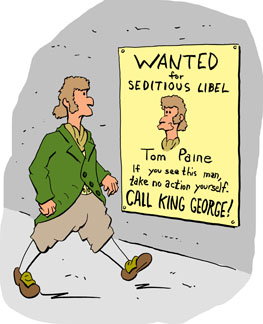
Tom realized he had to leave.
What do you do if your true talent is writing revolutionary papers and the revolution is over? Tom claimed he never received any money from either Common Sense or the American Crisis and found himself with virtually no funds. He turned to Congress for help. Naturally the request got bogged down in the bureaucracy, but Pennsylvania's Assembly voted him a lump sum of £500 (quite good money at the time). Then New York voted to give him a farm in New Rochelle.
For some reason Tom decided that Philadelphia's Schuylkill River needed a better bridge. So he spent time on the farm designing one made of iron rather than the more usual timber. But by 1787, he still hadn't had much luck drumming up financing.
Perhaps, he thought, the English might be more enterprising, and he went to London to look for backing. He had no more luck there but managed to build a prototype in an empty field. Naturally this enterprise didn't make much money, but he did get an (English) patent for it.
It was this time that Edmund Burke had written "Reflections on the French Revolution" which denounced the current French uprising against the monarchy. Ironically, Edmund had been one of the American colonists' staunchest supporters, but the French Revolution, Edmund said, was dumb. They were trying to make lowly occupations as honorable as the better - something Americans did not claim. "The occupation of a hair-dresser or of a working tallow-chandler," Edmund said, "cannot be a matter of honour to any person."
Tom read the book, and with his revolutionary bile risen, immediately dashed off the Rights of Man which continued the thinking of Common Sense. "As Mr. Burke occasionally applies the poison drawn from his horrid principles," Tom vented, "not only to the English nation, but to the French Revolution and the National Assembly, and charges that august, illuminated and illuminating body of men with the epithet of usurpers, I shall, sans ceremonie, place another system of principles in opposition to his." Among other things, Toms said, monarchy should be replaced with a republic which provided for public works using a graduated income tax. The class system and nobility should be abolished. All jobs and professions were honorable. It was being a leech of the nobility that was a disgrace.
Normally this pamphlet, now a classic of Republican philosophy, would not have caused much consternation. But the French revolution, which by late 1792 would replace King Louis XVI's monarchy with a radical republic, was making the English uppercrusts very nervous. They decided Tom was actively trying to foment a similar revolution in his home country. An order was issued for his arrest for seditious libel and the Rights of Man was banned. Tom was tried and found guilty. Fortunately (for Tom), the trial had to be conducted in absentia since he had left England for France and the new revolution.
Across the Channel
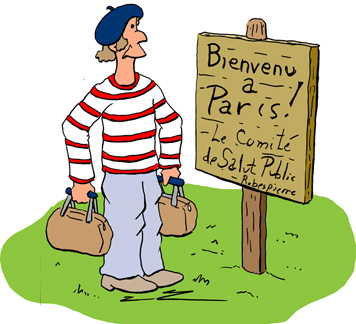
Le Citoyen Sans-Culottes.
After the Rights of Man was published, Tom found himself a celebrity and hero in France. Once he arrived in Paris, he was immediately made a citizen and voted a member of the French legislative body, the National Assembly.
For Tom, the French Revolution, embodied everything a revolution should. The nobility had been completely abolished, and land had been redistributed. The power of the Catholic clergy had been reduced to where no one religion had any more influence than any other. Best of all votes for all citizens (that is, all male citizens) was assured.
When Tom sat down in the Assembly the ongoing debate was on what to do with the recently deposed Louis XVI, now referred to simply as Citizen Louis Capet. Louis was accused of opposing the revolution and plotting to bring France's enemies in to fight the Republicans.
Both of these charges were true enough, and Louis had been trying to get Marie's relatives in Austria to invade France and restore him him as absolute monarch. In fact, he had escaped from Paris disguised as a merchant and had been apprehended just before he had reached the Austrian border. Now a good chunk of the Convention wanted to have Louis executed. But Tom opposed capital punishment in general. and besides it was the system of monarchy that caused the problems not the individuals. So he argued that Louis should be freed and then simply deported. Tom's proposal was voted down, and Louis went to the guillotine on January 21, 1793, followed ten months later by his wife, Marie Antoinette.

Tom thought Louis should be freed.
Unfortunately, although France was now free of monarchy, the revolution was not going smoothly. Fueled by zeal, patriotism, and a misplaced sense of invincibility, France had declared war on just about every European country and was trying to force their new way of government on everyone else. The members of the National Assembly soon found that war was expensive, and without trained generals, battles were easy to lose. Food crises hit the nation, and inflation went through the roof.
On the home front there were two primary political factions, the Jacobins and the more moderate Girondins. Then in April 1793, the Jacobins took power with the formation of the Committee of Public Safety headed by Maximilien Robespierre. Robespierre and his friends immediately passed laws giving themselves absolute power, and by September, the Terror was in full swing. How many people died is not known and modern estimates range from "only" 20,000 at the low end to perhaps 100,000 overall. But in Paris alone dozens of executions were being conducted daily. The worst crime was being someone who did not wholeheartedly support the revolution. People, for instance, who voted to spare Louis's life.
Yes, on December 23, 1793, Tom was arrested for anti-revolutionary activities. He was given a trial, but to speed things up the courts no longer required the defendant to be present or even have a lawyer. Naturally Tom was found guilty and dispatched to Luxembourg Prison.
At first the accommodations were pretty good. Tom had two large rooms in the prison which had at onetime had been a palace. And as in prisons today, the inmates had reasonable freedom to walk around during the day, and Tom had good food that was brought in from local restaurants.
If nothing else, the time in the Luxembourg gave Tom the - quote - "leisure" - unquote - to expand the Rights of Man. In addition to advocating Republicanism, Tom also began to attack organized religion. Although he himself did accept the existence of a Supreme Being, he also believed (as did Albert Einstein) that doctrines of all organized religions were nothing more than superstitions polished up to a veneer of respectability. For someone in jail for being an anti-revolutionary, his sentiments fit in surprisingly well with new French laws which had begun replacing religious holidays with manufactured secular celebrations which today sound rather silly. But in Britain, America, and even in most of France, the traditional religions still had strong popular support, and the religious writings of the Rights of Man soured a lot of people on Tom's philosophy. Soon people began to splutter that Tom was nothing more than a fatuous, pompous, and malcontented atheist.
We shouldn't make it look like Tom's life in prison was pleasant. Every day he could hear people being hauled away, kicking and screaming, for execution. You had no idea if when you woke up in the morning whether you would be taken to the guillotine. By April 1794, the warden decided it was time to quit coddling the criminals, and he put Tom into a small cell, although he was still allowed to spend time in the common room with others.
What happened next was something you might think is an Internet legend. It does, though, have primary documentation. Or at least Tom told the story himself.
Tom had written to the American ambassador, Gouverneur Morris (Gouverneur was his name, not a misprinted political title) for help. Gouverneur, much to Tom's chagrin, said he was ignorant of the cause of Tom's detention, but he - and this is a quote - "must conclude they are well-founded". To his credit, Gouverneur had consulted with François Louis Michel Chemin Deforgues, the French Minister of Foreign Affair about Tom. François replied that because Tom was now a French citizen, he was subject to the laws of France. So it was not proper for him to appeal to the consulate of a foreign country. Tom then responded to Gouverneur in a manner you would not expect from someone asking to be rescued from the guillotine.
Tom had no illusions about his situation. An average of thirty prisoners a day were being hauled off to the guillotine and in one night 161 men were executed. Whether it was some physical illness due to the crowded conditions or a nervous breakdown, in June Tom collapsed into semi-consciousness. Because of his illness, he was moved to a larger cell but he had to share it with three other prisoners, Michael Rubyns, Charle Bastinit, and Joseph Van Huele, all from Belgium. Four men in a cell (sounds like a sit-com title, doesn't it?) can be a bit cramped and to improve ventilation they were allowed to keep the door open during the day.
The night before the executions, the jailer went around marking the cells of the people to be executed. But because Tom's door was open, the jailer chalked the number "4" on the inside of the door (the number was to indicate how many of the prisoners were to be taken out). That night, though, Michael, Charles, and Joseph (Tom was still comatose) knew there would be a change in jailors in the morning. So they shut the door (and presumably erased the mark). The next day, seeing no mark, and the guards paused at the door and then moved away. A few days later, the National Convention voted to oust Robespierre, and the Committee of of Public Safety was disbanded. Robespierre himself went to the guillotine the next day, and the prisoners condemned during the terror were granted stays of execution. Despite stories that Tom was released once Robespierre was dead, he actually stayed in prison for seven more months and wasn't freed until November.
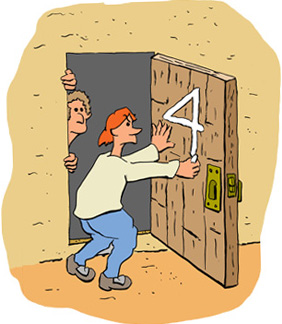
Tom was in prison.
Is this story of Tom's brush with death true? Well, historians have every right to write it up that it is, and most do. After all, the primary source was an actual participant - Tom himself. But we also need to remember that Tom had been semi-conscious throughout the episode and so must have heard it second hand from his cell mates. Either that or he simply made it up. It would certainly seem strange that when the jailor who marked the door came back on duty, he would not have noticed the prisoners still sitting happily in their cell. So there are reasons to doubt the story, but still, it could have happened.
But whatever the circumstances, Tom's time in prison did nothing to improve his opinion of the men who had crafted America's new Federal Constitution. He was particularly irked that the current president, George Washington, whom Tom had known well, did not use his influence to get him sprung.
Tom wrote a lengthy and famous letter full of spittle flinging diatribes venting his displeasure. He trashed everything about the new American nation, ranging from the deficiencies of the new Constitution, claims that John Adams thought the US presidency should be hereditary (with a dig at George's lack of natural children), George getting rich from being president (actually, George lost money), and finally, he recounted the terror in France with Robespierre. The letter was - as Oscar Wilde claimed his were - intended for publication and appeared in the third volume of the Rights of Man as well in a separate brochure. Tom was really irritated how George, once the revolution was won, had simply kept the status quo (like keeping slavery), and spluttered "the world will be puzzled to decide whether you are an apostate or an impostor; whether you have abandoned good principles, or whether you ever had any." As far as he was concerned, the old American revolutionaries had were no better than the old French and English nobility, and in someways were worse.
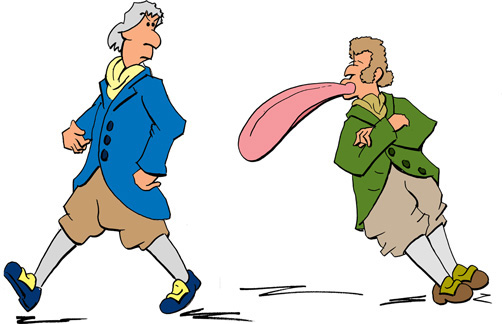
Tom never forgave George.
But even in France, revolution was on its way out. In 1799, a young Corsian officer named Napoleone Buonaparte staged a coup, restored the nobles their land and titles, and set himself up, first as Consul and then later as Emperor. La révolution est morte! Vive la révolution!.
Tom stuck it out for a few more years, but decided he could either stay in France and live in a dictatorship, return to England where he was still wanted for seditious libel, or go back to the former colonies. Choosing what he thought the lesser of three evils, Tom sailed for America in September, 1802.
America - Again
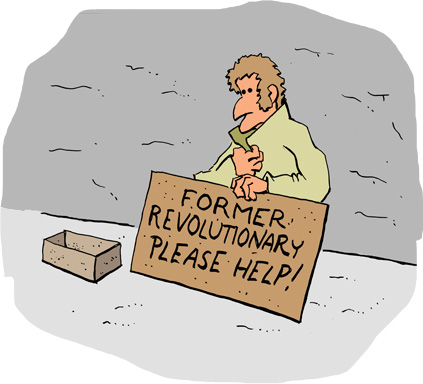
Tom Paine: The Success
What Tom was like in his later years depends on who you ask. The usual picture is of a person who drank a quart of hard liquor a day and wandered the streets in ragged clothes. It is fashionable to quote a letter from William Carver who put Tom up in the winter of 1805 and 1806. William wrote he had to give Tom a bath three times before he was presentable, and that his toenails were grown so long they curved as long in front as they were in back. Tom's morality was also questioned and the child of one of Tom's landladies was supposed to look suspiciously like "that stinking atheist".
But others said all this talk was just smear tactics against a man who had unconventional views and whom Americans resented for criticizing George Washington, whom for all practical purposes had become deified. Aaron Burr recounted that Tom often dined with him and was always properly dressed and did not drink to excess. One man who used to drive Paine around said he was kind even to children and would not hesitate to stop and give a friendly pat on the head to the neighborhood dogs.
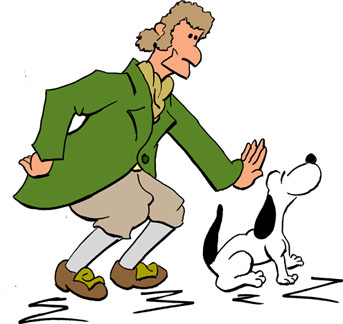
Tom would stop.
When a historian encounters a lot of conflicting stories, this does not necessarily mean we have unreliable witnesses, but rather it is an indication of the variable behavior of the subject. As far as Tom's imbibing, we must remember that the years 1790 and 1820 saw a huge increase in American consumption of hard liquor, partly because alcohol was touted as healthful and beneficial and partly because rum, made from sugar cultivated by vast slave plantations in the Caribbean, had become cheap. A quart of rum a week was now quite typical for a vivacious colonist, and a pint a day, although on the high end, not exceptional. Even drinking early in the day was common. John Adams began his morning with a glass of hard cider as did many others, but when away from New England, John started the day with a mug of beer. You'd have drinks with lunch, and instead of coffee breaks you'd take liquor or beer breaks. Of course you drank at dinner and ended up the day with a nightcap. What we conclude is Tom, like Edgar Allen Poe, went through times he drank relatively little and times he drank more.
Tom died in 1809 and was buried on his farm in New York. In 1820 his body - now reduced to bones - was exhumed by William Cobbett a British political radical and writer who had lived in America. Oddly enough, William had written attacks on Tom's ideas, but now he seemed to think Tom should be interred with suitable honors in his native country. However, the plans went awry and subscribers for the Tomb of Tom never materialized.
We shouldn't be surprised that few people with money wanted to honor Tom. By the early 19th century, Tom was a controversial figure who the rich and powerful believed had advocated mob rule and plotted the destruction of religion. Even up to the 20th century, historians sometimes wrote how Tom's writings did "some good but much harm." Tom was a Fallen Father.
At first William kept Tom's bones in his home in London, but with so much trouble getting people to help him establish a suitable resting place for one of the most important political thinkers in history, he moved Tom to his farm in Sussex. After that it seems that bits and pieces of Tom were taken away for souvenirs. Supposedly a bit of his brain was shipped back to America and put back where Tom was originally buried. Later a couple of locks of hair together with a wax death mask (all marked as "no commercial value" by customs) were shipped to the Tom Paine Museum in New Rochelle. By one account, a cleaning lady, not knowing the fragments were human, turned Tom over to a rag and bone man. However, others thought the cleaning lady knew whose bones they were and disposed of them - to quote one writer - "more profitably". Tom's skull may even have ended up in Australia.
Today Tom is as controversial as ever. Internet discussions (a rather laughable word for infantile name calling hidden behind the anonymity of cyber pseudonyms) go back and forth as to whether Tom did or did not believe in God, and even was he or was he not a "Founding Father". Was he even an American? Tom clearly thought so and so he was particularly chagrined when he tried to vote in New York - only to be turned away because he was British!
You might hear that there were no statues of Tom in the United States and that the only one set up was in 1964 in Thetford, his home town in England. Even then the mayor said he would not approve the statue unless it stated Tom was a convicted traitor. If that's true, then the motion was clearly overruled, and the statue was cast and stands on King Street.
Then in 1975, the Historical Society of Brodenstown, New Jersey, a town in which Tom had lived in for some years, decided Tom merited a statue there. It was erected in 1997. The British, not to be outdone, erected another statue of Tom on July 4, 2010 in Lewes.
But really the first claim for putting up a statue to Tom is indeed from America. On July 4, 1950, the town of Morristown, New Jersey unveiled a statue to whom at least their own citizens accepted as an American. A modest CooperToons opinion is that this is the best of the few that do exist.
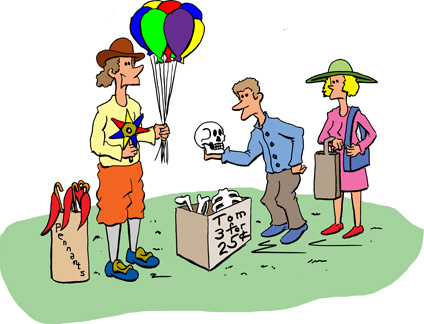
Souvenirs
References
Tom Paine: A Political Life, John Keane, Little, Brown, 1995
Thomas Paine: His Life, Work, and Times, Audrey Williamson, St. Martin's Press, 1973
Common Sense, Thomas Paine, Online Edition, http://etext.lib.virginia.edu/toc/modeng/public/PaiComm.html
"Tom Paine", The Mark Steel Lectures, Season 2, Episode 4, 2004.
The Life of Thomas Paine, Daniel Conway, Moncure Daniel Conway, Scribners, New York, 1892. Online editions are available.
"Thomas Paine 1737 - 1809, the "Father of the American Revolution", http://www.nellbrinkley.net/tompaine.htm
"Statue of Thomas Paine Unveiled in Lewes" http://www.bbc.co.uk/news/10507823
"Thomas Paine Sculpture Being Created in Lewes", http://news.bbc.co.uk/2/hi/uk_news/england/8508795.stm
"Thomas Paine's Remains Are Still a Bone of Contention", Los Angeles Times, April 01, 2001. The date of the article makes you wonder.
"Paine's Long Lost Remains Home by Parcel Post", William M. van der Weyde, New York Times, May 31, 1914.
"A Reexamination of William Cobbetts Opinions of Thomas Paine", Claribel Young, Journal of the Rutgers Universisties Libraries, Volume 39, 1977
Boston Massacre Historical Society, http://www.bostonmassacre.net/index.html
"Boston Massacre Trials", Famous Trials, Douglas Linder, University of Missouri-Kansas City Law School, http://law2.umkc.edu/faculty/projects/ftrials/bostonmassacre/bostonmassacre.html
The Alcoholic Republic: An American Tradition, William Rorabaugh, Oxford University Press, 1979